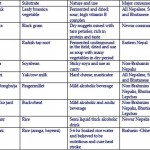The recent post on fermentation clearly struck a chord with our friend and colleague Bhuwon Sthapit of Bioversity International. Here’s his contribution to the discussion.
It is interesting to note the myriad different ways in which locally available cereals and other sources of food are fermented by local people through the action of microorganisms, either naturally or by adding a starter culture, which modifies the substrate biochemically and organoleptically into and edible product, generally nutritious, tasty and safe. These inexpensive, culturally acceptable traditional foods provide basic diets and sources of nutrition. In the Hindu-Kush Himalayan region alone more than 20 varieties of ethnic fermented food are found and more than 10 types of fermented beverages are consumed in Nepal, Sikkim and Bhutan. Most of them are common, while other fermented foods are less familiar and confined to particular communities and locations.
For example, Rai and Limbus in Eastern Nepal use a special finger millet variety to prepare Tongba (fermented millet drunk through a straw after adding hot water), which is very nourishing and the by products are used for pig and poultry rearing. The Tharus prepare Jaad using Anadi rice. They keep it up to one year. They also prepare Mad from a rice landrace (a special variety called Simpthyari or Sathi). They mix a small quantity of rice and local soybean in 3-4 liters of water and cook for a long time until the rice converts into a liquid. Then they keep in a Ghaila adding cold water for natural fermentation and drink within 3-4 days. This drink is considered nutritious and reduces body temperature if drunk during periods of extreme heat. Priority is given to children when they return from morning school around 11 AM. They also drink Mad during farm work in the day time.
Jyapu farmers — the indigenous ethnic Newar community of the Kathmandu valley — grow Taichung japonica rice to prepare fermented rice locally called Tho (the white solid is served to lactating women or water is added to make beverages during the rice planting season). They believe that the nutritive value of rice and the taste are improved.
Here’s a table listing a few ethnic fermented foods from the Hindu-Kush Himalayan region (click to enlarge).
There are rich sources of traditional knowledge on fermented food culture in a wide range of locally abundant foods. Farmers use this simple, inexpensive technique to improve the quality of food and taste. Projects that address nutrition and agricultural biodiversity need to bring in this age-old practice in consideration as well. Some interesting work has been done by Jyoti Prakash Tamang in Sikkim.
Jyoti Prakash Tamang et al. (2007). Food consumption in Sikkim with
special reference to traditional fermented foods and beverages: A micro-level survey. Journal of Hill Research 20(1).
